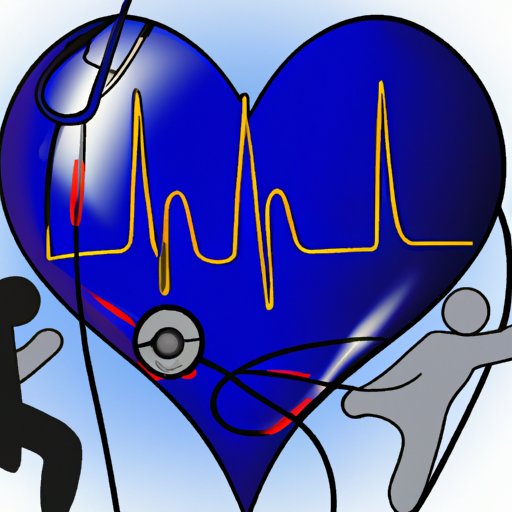Introduction
Cardiovascular health is a key indicator of overall health and wellbeing. A healthy heart is vital to maintaining an active lifestyle, and regular physical activity is a great way to keep your heart in top condition. Exercise can help improve blood flow and oxygenation, reduce cholesterol levels, and even help lower your risk of developing heart disease.

Analyzing the Benefits of Exercise on Cardiovascular Health
Regular exercise can have a positive effect on your cardiovascular system. Here are some of the ways that exercise can benefit your heart:
Improved Blood Flow and Oxygenation
Physical activity increases the amount of oxygenated blood that flows throughout the body. It also helps your heart pump more efficiently, which means more oxygen reaches your cells. This can lead to improved overall health and increased energy levels.
Positive Effects on Cholesterol Levels
Exercise can help lower bad cholesterol (LDL) and raise good cholesterol (HDL). Regular exercise can also reduce triglyceride levels, which are a type of fat found in the blood. All of these factors help reduce your risk of developing heart disease.
Weight Loss and Improved Body Composition
Regular exercise can help you lose weight, which is beneficial for your heart health. Weight loss can help reduce your risk of developing heart disease and stroke by reducing your blood pressure and improving your cholesterol levels. It can also help improve your body composition, which is the ratio of fat to muscle in your body.
Examining the Impact of Exercise on Heart Disease Risk Factors
There are several risk factors associated with heart disease, such as high blood pressure, abdominal fat, and insulin sensitivity. Regular exercise can help reduce these risk factors and improve your overall heart health.
Lowering High Blood Pressure
High blood pressure is one of the most common risk factors for heart disease. Exercise can help reduce your systolic and diastolic blood pressure levels, which can help reduce your risk of developing heart disease.
Reducing Abdominal Fat
Abdominal fat is linked to an increased risk of heart disease. Exercise can help reduce abdominal fat, which can help reduce your risk of developing heart disease.
Improving Insulin Sensitivity
Exercise can help improve your body’s sensitivity to insulin, which is important for regulating blood sugar levels. This can help reduce your risk of developing type 2 diabetes and other chronic diseases, both of which are associated with an increased risk of heart disease.

Exploring the Link Between Physical Activity and Coronary Heart Disease
Coronary heart disease is a leading cause of death in the United States. Exercise can help reduce your risk of developing coronary heart disease by reducing the size of coronary artery plaque, which is made up of cholesterol and other substances that can block the arteries. Exercise can also reduce your risk of having a heart attack or stroke.
Investigating the Effect of Exercise on Blood Pressure Levels
Exercise can help reduce your systolic and diastolic blood pressure levels, which can help reduce your risk of developing heart disease. Exercise can also improve arterial elasticity, which is the ability of the arteries to expand and contract. This can help improve blood flow and reduce your risk of developing heart disease.

Understanding the Relationship Between Exercise and Heart Rate
Exercise can have a positive effect on your resting heart rate, which is the number of times your heart beats per minute when you are at rest. Aerobic exercise can help reduce your resting heart rate, which can help reduce your risk of developing heart disease. Anaerobic exercise can increase your maximum heart rate, which is the highest number of times your heart can beat in one minute.
Looking at the Role of Exercise in Reducing the Risk of Congestive Heart Failure
Exercise can help strengthen the heart muscle and improve its efficiency. This can help reduce the risk of congestive heart failure, which is a condition where the heart is unable to pump enough blood to meet the body’s needs. Exercise can also improve the quality of life for those with congestive heart failure by improving their ability to perform daily activities.

Reviewing the Evidence for Exercise as a Treatment for Cardiac Conditions
Exercise has been shown to be an effective form of preventive medicine for many cardiac conditions. It can also be used as a tool for rehabilitation after a heart attack or other cardiac event. Studies have shown that regular exercise can help reduce the risk of recurrent cardiac events, as well as help improve overall quality of life.
Conclusion
Exercise is an important part of a healthy lifestyle. It can help improve your cardiovascular health by increasing blood flow and oxygenation, reducing cholesterol levels, and lowering heart disease risk factors. Exercise can also reduce your risk of developing coronary heart disease and congestive heart failure, and can be used as a tool for rehabilitation after a cardiac event. To get the most out of your exercise routine, make sure to consult with a doctor before beginning any new exercise program.
(Note: Is this article not meeting your expectations? Do you have knowledge or insights to share? Unlock new opportunities and expand your reach by joining our authors team. Click Registration to join us and share your expertise with our readers.)
